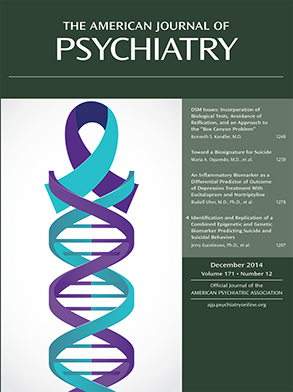Few areas of medicine anticipate biological markers of disease more eagerly than psychiatry. After many decades with little solid understanding of pathophysiology, this issue of the Journal includes three reports suggesting associations between real-world psychiatric outcomes—antidepressant response or suicide—and markers of disease.
Like a dog that unexpectedly catches a car he’s been chasing down the street, it would serve us well to consider why we’re chasing the biomarker vehicle in the first place. At the most basic level, the discovery of disease-relevant biology reminds us that these are brain diseases—biologically based illnesses arising from the interplay of genomic and environmental risk. Sadly, in an era when major U.S. media outlets still routinely question the usefulness of treating depression, such simple reminders play a useful role. They provide an opportunity for clinicians to underscore for patients, families, and ourselves that, yes, these are hard but ultimately tractable problems.
In an investigation of genome-wide patterns of methylation in postmortem brain samples, Guintivano et al. (
1) identify an association between methylation in the
SKA2 gene and death from suicide, in three distinct sets of samples. They then go on to detect, in an examination of peripheral blood, an association with thoughts of suicide, and they suggest correlation in samples of waking salivary cortisol as well. More broadly, the study nicely demonstrates two important design elements of biomarker studies aimed at clinical translation: the inclusion of replication samples, to help protect against false positive findings and provide more realistic estimates of effect size, and the effort to translate from a postmortem observation to a potentially actionable peripheral blood marker. It also illustrates the challenges of moving toward a clinical test, presenting receiver operating characteristic curves (a measure of classification accuracy) that are likely to be somewhat optimistic regarding actual clinical utility.
Biomarkers also provide a potential starting point for development of new treatments, and potentially a means of accelerating treatment development. Wong et al. (
2) used next-generation sequencing to examine rare variants among 65 Mexican American individuals with major depression who completed 8 weeks of antidepressant treatment. The work is notable because it examines a highly understudied group; most large-scale psychiatric genetic studies to date have focused on northern Europeans in order to minimize the risk of confounding due to admixed populations. Whatever the scientific merit of that strategy, the result is that we know remarkably little about the impact of common or rare variation in non-northern European cohorts. The work of Wong et al. suggests association with overall treatment response for one genetic variant, in an intergenic region known to be methylated in a human postmortem data set. If this signal can be confirmed and refined in one of the other extant antidepressant data sets, the finding could help to clarify the mechanism by which antidepressants act, and thus provide targets for developing new generations of antidepressant treatments.
However, the temptation is always strong to leap to a more immediate application of biomarkers, to finally allow more precision in diagnosis and treatment in psychiatry. In the third report in this issue, Uher et al. (
3) describe a straightforward analytical inquiry: Does a marker of systemic inflammation, C-reactive protein (CRP), identify a subgroup of individuals more likely to respond to either escitalopram or nortriptyline? With an eye toward clinical use, they report their effects in terms of variance explained—that is, how much of the variation in an individual’s response can be explained by CRP level. They also make an underappreciated observation, namely, that biomarkers need not be applied alone but perhaps may be even more useful in combination with clinical or sociodemographic markers. Thus, they find that by combining CRP level with a symptom-based score, they can explain nearly 16% of variance. Uher et al. are circumspect in their conclusions, noting that while the effect size exceeds a standard metric for clinical usefulness, replication is a key next step before clinical application.
Taken together, these three reports provide further evidence that the “hard” problems of neuropsychiatric disease have begun to yield to systematic study. Ultimately, biomarkers offer great promise for speeding treatment discovery and development and for improving the precision of diagnosis and treatment. Presenting results in both a scientific and a clinically interpretable way will help bridge the translational gap. Receiver operating characteristic curves do not actually answer a question clinicians are likely to ask, but they at least move the conversation toward classification accuracy. Indeed, it remains critical to remember the distinction between statistical and clinical significance; while the former can be assessed independently of context, the latter requires careful consideration of context and alternatives. For example, while distinguishing serotonergic and noradrenergic mechanisms of action may point toward new mechanisms or augmentation strategies, it is entirely possible that simply treating patients with dual-acting antidepressants will ultimately prove a more efficient strategy than applying a biomarker-based test.
Translating the leads provided by these three studies will also require that the field address the need for true, adequately sized replication cohorts. Much like inclement weather, everyone complains about it, but little is done about it: for bench work to inform clinical practice, there is now a pressing need for cohorts in which emerging outcome predictors can be followed up. The lesson from psychiatric disease genomics as a whole is clear: separating the wheat from the chaff requires large numbers. Only concerted effort and collaboration are likely to allow us to translate from the potential of scientific excitement to the reality of clinical innovation.

